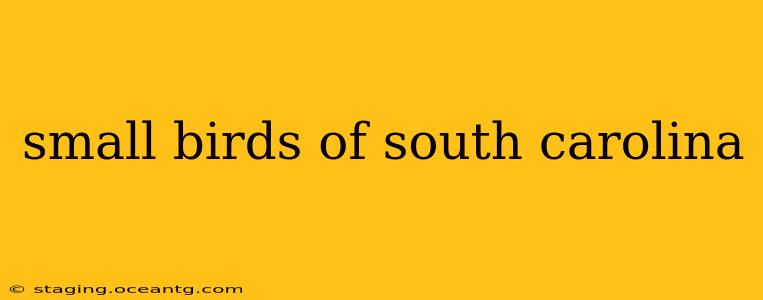South Carolina, with its diverse habitats ranging from coastal marshes to mountainous forests, boasts a vibrant population of small birds. Identifying these feathered friends can be a rewarding pastime, and this guide aims to help you discover some of the most common and fascinating species found in the Palmetto State. We'll explore their characteristics, habitats, and behaviors, providing you with the knowledge to better appreciate the avian wonders of South Carolina.
What are some common small birds in South Carolina?
This question opens the door to a wide variety of species. Some of the most commonly spotted small birds in South Carolina include:
- Carolina Chickadee: This tiny, active bird is easily recognized by its black cap, bib, and white cheeks. They are year-round residents, often found in woodlands and parks.
- Northern Cardinal: A vibrant splash of color, the male Northern Cardinal is unmistakable with its bright red plumage. Females are a more subdued brown. They are common in a variety of habitats.
- Tufted Titmouse: A gray bird with a prominent crest on its head, the Tufted Titmouse is a familiar sight in backyards and wooded areas.
- Downy Woodpecker: The smallest woodpecker in North America, the Downy Woodpecker is a frequent visitor to backyard bird feeders. Look for its black and white checkered pattern.
- House Wren: This tiny, energetic bird is known for its loud, bubbling song. They often nest in birdhouses and cavities.
- American Goldfinch: With its vibrant yellow plumage (males) and cheerful song, the American Goldfinch is a delight to observe. They are seed-eaters and frequent feeders.
What are the smallest birds in South Carolina?
Determining the absolute smallest can be tricky, as size can vary slightly within species. However, some of the contenders for the title of smallest birds in South Carolina include the Ruby-crowned Kinglet and the Golden-crowned Kinglet. These tiny birds are incredibly active and often difficult to spot due to their size and habit of flitting through dense foliage.
Where can I find small birds in South Carolina?
South Carolina’s diverse geography offers a wide range of habitats for small birds. To increase your chances of spotting them:
- Backyards and Parks: Many common small birds are readily found in urban and suburban areas. Planting native shrubs and trees, and providing bird feeders and water sources can attract a variety of species.
- Forests and Woodlands: These areas provide excellent habitat for many woodland species, including chickadees, titmice, and woodpeckers.
- Coastal Marshes and Wetlands: These habitats are home to a variety of small birds adapted to life near the water, including various sparrows and warblers (during migration).
- Gardens and Fields: Open areas with wildflowers and native plants can attract seed-eating birds like goldfinches and sparrows.
What is the best time of year to see small birds in South Carolina?
Migration periods (spring and fall) bring a surge in bird diversity as numerous species pass through the state. However, many small bird species are year-round residents and can be observed throughout the year. Spring and summer offer the best chances to hear their songs and observe nesting behaviors.
How can I identify small birds in South Carolina?
Proper identification requires careful observation. Consider these key features:
- Size and Shape: Note the bird’s overall size and body proportions.
- Plumage: Pay close attention to the color and pattern of the feathers. Males and females may have different plumage.
- Behavior: Observe how the bird moves, forages, and interacts with its environment.
- Song and Calls: Bird songs and calls are often distinctive and helpful in identification. Using a bird identification app or field guide can assist with this.
By combining careful observation with the use of reliable resources, you can significantly improve your ability to identify the small birds that call South Carolina home. Happy birding!
